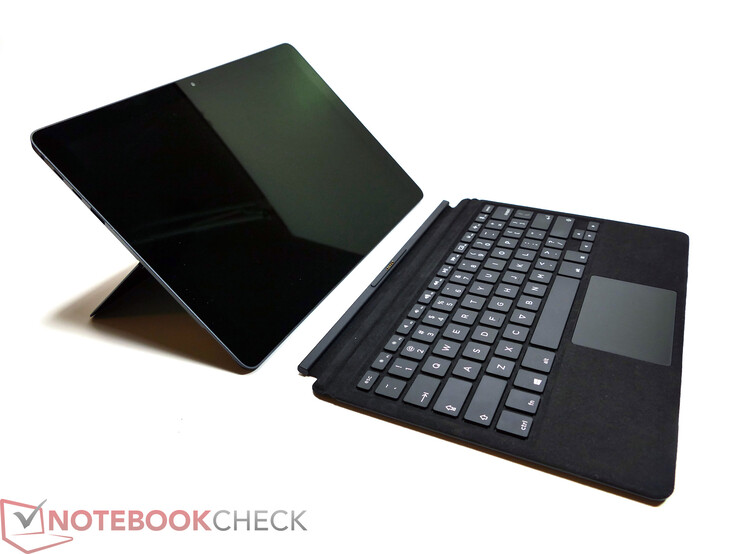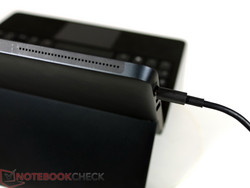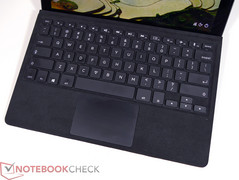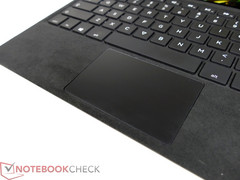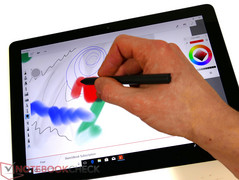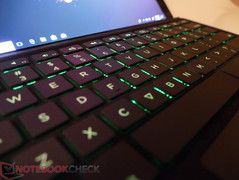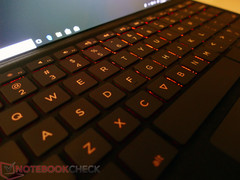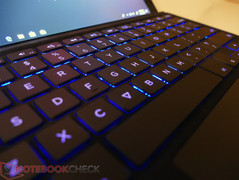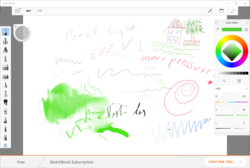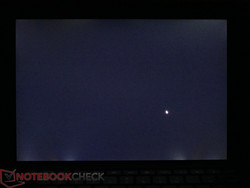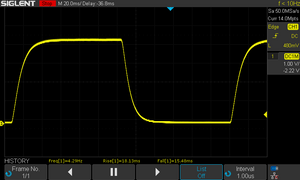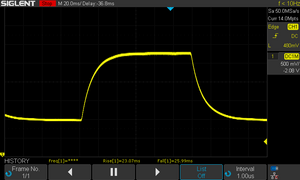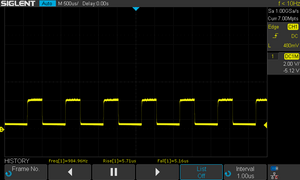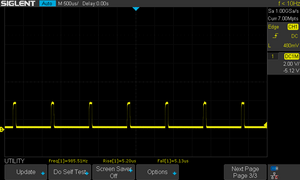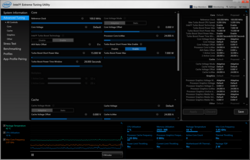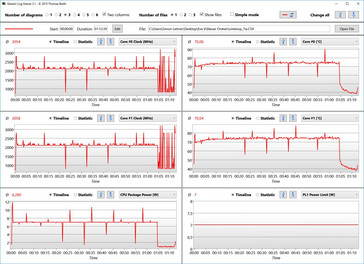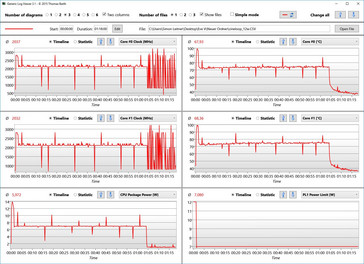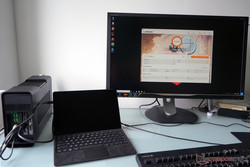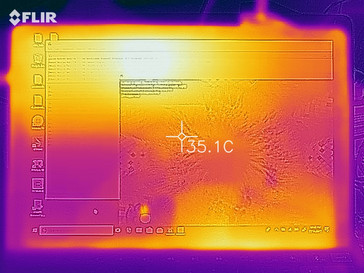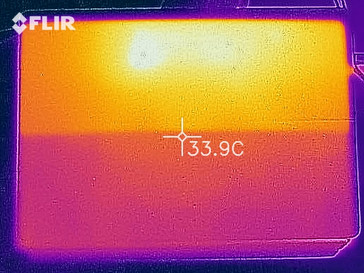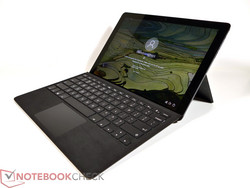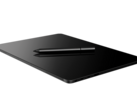Eve V (m3, i5, i7) Convertible Review

For the original German review, see here.
A device designed exclusively following user requests, without any annoying market or price strategies. Sounds too good to be true. Eve-Tech claims to have achieved the impossible, and with the Eve V, it is presenting a convertible which follows the example of the Microsoft Surface Pro, while supposedly having implemented all of its features for a much smaller budget. According to the manufacturer's own claims, it is the first crowd-developed 2-in-1 device. More than 1000 future users are supposed to have contributed to the development of the Eve V convertible. You can find out in the following review, whether the Eve V can keep its promises or too many cooks have spoiled the broth and it did not quite come out as planned.
Case
Aluminum, glass, and Alcantara are the ingredients from which the Eve V was conjured up. The tablet unit itself is made from aluminum (unibody) with a velvety matte, black surface. The sides are slanted towards the back, and the corners are slightly rounded. The haptic is extremely pleasant, and the device feels very good in the hands. The thickness of the tablet is specified as about 9 mm (~0.35 in), but it appears even slimmer because of the design. The glass top (Gorilla Glass) above the display is fitted tightly into the aluminum case, without any noticeable expansion or gluing gap.
The kickstand is set into the back of the tablet case. Notches on the side facilitate the controlled opening of the kickstand up to an angle of around 125 degrees. The two hinges allow a smooth adjustment of the angle across the whole opening range.
At a thickness of about 7 mm (~0.28 in), the keyboard dock is one of the more bulky ones of its kind and attaches to the tablet via magnets. As soon as the magnets come close enough to each other, it automatically slides into place. An additional notch in the back area of the keyboard allows placing it either flat on the table, or fixing it at a slight angle. The top and bottom of the keyboard are covered with Alcantara, offering the typical smooth suede-like feel. A plastic strip around the edges provides additional protection. Not only does the keyboard feel great out of the box with its textile surface, but it also looks good. However, we can only speculate how it will look after a year or two of daily use. The areas between the keys in particular are hard to clean and might become affected over time.
In terms of stability the Eve V, i.e., the tablet and the keyboard, appears to be beyond criticism. The display unit seems to be made from a single cast, and the generous thickness of the keyboard also adds to its stability. The only fault we found in one of our test units is that in one of the two hinges, a metal part appeared slightly displaced. Even though this did not impact its proper functioning, if it were to lead to a defect at a later time, the repair might be complicated, since you can only get to the components inside by removing the display - probably an impossible task for an average person.
With its 1.36 kg (3 lb), the Eve V is one of the heavy weights among the 12 to 13-inch convertibles. The Yoga 920 from Lenovo is unusual here, since not only it is much larger with its 13.9-inch display, but also differentiated from the other selected comparison devices by its 360-degree folding mechanism. The fact that at 1.37 kg (~3.02 lb), it is only negligibly heavier than the Eve V only proves to show that the Eve brings a few more pounds to the scale than the competitors.
Connections
The decision to integrate the new Type-C connections as well as two conventional Type-A ports into the device was a result of the cooperation with a number of future users in the development phase. Even though the device becomes slightly thicker due to the full-size USB ports, on the other hand you do not need any adapters. On the left edge, the Eve V offers one Type-C Thunderbolt 3 port (40 Gbps), one Type-C (3.1 Gen. 1, 5 Gbps), and one full-sized USB-3.0 port, as well as a headphone jack. On the right edge, another 3.0 port (Type-A) completes the connections offered. Compared to the classic XPS 13 Ultrabook, the Eve V is even one Type-C connection ahead with this, but the Type-C is also used for charging the device. Microsoft's Surface Pro offers only one USB 3.0 Type-A port and one Mini DisplayPort.
Now we come to our practical experiences during the test. Because of the slanted edges on the sides, the smaller Type-C plugs in particular sit slightly loose in the case (especially the included charging cable). This can even go so far as the contact being lost while transferring data or charging, which happened a few times during the test. In this, we saw a difference between the Type-C port (USB 3.0) on top and the lower Thunderbolt port, which was holding the plugs tighter in position. The second problem is that the two Type-C ports are not labeled. So you should remember that the more central Type-C port is the one with the Thunderbolt 3 functionality. By the way, you can charge the Eve V with either of the Type-C ports, which is a clear advantage, for example to the Xiaomi Mi Pro that we tested recently.
SD Card Reader
Testing with a Toshiba Exceria Micro SDHC 32GB UHS-I card, we achieve an average transfer rate of almost 70 MB/s when copying image files to the Eve V, which ensures a good position in the comparison. There are only a few devices, such as the XPS 13, that connect the SD card reader faster and can achieve much faster transfer rates. In the case of detachable devices, the presence of a way to expand the storage or an easy method to import data from a storage card is already an advantage.
| SD Card Reader | |
| average JPG Copy Test (av. of 3 runs) | |
| Dell XPS 13 i5-8250U (Toshiba Exceria Pro SDXC 64 GB UHS-II) | |
| Apple MacBook Air 13.3" 1.8 GHz (2017) (Toshiba Exceria Pro SDXC 64 GB UHS-II) | |
| HP Elite x2 1012 G2-1LV76EA (Toshiba Exceria Pro M501) | |
| Lenovo ThinkPad X1 Tablet Gen 2 (Toshiba Exceria Pro SDXC 64 GB UHS-II) | |
| Eve-Tech Eve V i5 (Toshiba Exceria microSDHC 32GB UHS-I) | |
| Asus VivoBook Flip 14 TP410UA-EC242T (Toshiba Exceria Pro SDXC 64 GB UHS-II) | |
| Acer Spin 5 SP513-52N-54SF (Toshiba Exceria Pro SDXC 64 GB UHS-II) | |
| maximum AS SSD Seq Read Test (1GB) | |
| Dell XPS 13 i5-8250U (Toshiba Exceria Pro SDXC 64 GB UHS-II) | |
| Lenovo ThinkPad X1 Tablet Gen 2 (Toshiba Exceria Pro SDXC 64 GB UHS-II) | |
| Apple MacBook Air 13.3" 1.8 GHz (2017) (Toshiba Exceria Pro SDXC 64 GB UHS-II) | |
| HP Elite x2 1012 G2-1LV76EA (Toshiba Exceria Pro M501) | |
| Eve-Tech Eve V i5 (Toshiba Exceria microSDHC 32GB UHS-I) | |
| Asus VivoBook Flip 14 TP410UA-EC242T (Toshiba Exceria Pro SDXC 64 GB UHS-II) | |
| Acer Spin 5 SP513-52N-54SF (Toshiba Exceria Pro SDXC 64 GB UHS-II) | |
Communication
The Eve V is equipped with an Intel 8265 Wi-Fi module. The results of our transfer tests are impressive. Compared to other devices with the same module, the Eve V is midfield.
Security
The Eve V has a fingerprint reader, which is integrated into the On/Off button on the right edge towards the top. While this in itself worked reliably in the test with Windows Hello, since you cannot see the area on the edge and the button is not easily distinguishable by feel alone, it often happens that you miss the right place several times before your finger touches the sensor, which then reacts promptly.
Accessories
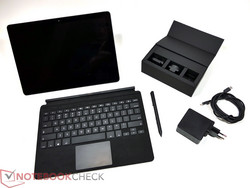
In our edition for backers of the Indigo campaign, we are finding some nice additions such as a poster with the names of all the initial supporters including a sticker for marking your own name. The power supply, which includes three plug inserts for the adapter as well as the US plug is a very good solution, making the Eve ready for worldwide use without the additional bulky adapters. The package also includes an active input pen and the keyboard, which are included in the price. Microsoft in particular deserves a rebuke for charging a hefty premium for their keyboard cover (starting at 149 Euros/~$175) and optional input pen (109 Euros/~$128) on top of the advertised prices of the Surface. We also find a bag with the Eve design as a goody in the box. We are pleased that the Eve V has omitted to "delight" the users with preinstalled bloatware.
Maintenance
As is customary for detachable solutions, unfortunately there is no way for users to get access to the insides of the Eve V. The aluminum case is completely closed and the display is glued tightly into the front. Only a repair professional might be able to take it apart with the aid of special tools. The same goes for the keyboard cover, which shows no way of being able to open it without destroying it.
Warranty
The Eve V is offered with two years of warranty. Should the repair take a long time, Eve-Tech promises to immediately send a replacement device to the user. Eve also offers the option of a replacement device in cases of a repair of user-caused damages, such as a cracked display. For the repair process, Eve works together with DHL/UPS, which will pick up the device from the user. In the case of a warranty, Eve will pay all the costs. Please see our Guarantees, Return Policies & Warranties FAQ for country-specific information.
Input Devices
Keyboard
When typing on the keyboard of the Eve V, you first and foremost notice the positive impact of the strikingly long stroke of the individual keys. At the same time, you hear a slight hollow thud, when you use the keyboard at the slight angle and there is airspace below the keyboard. This echo effect disappears when the keyboard lies flat on the table. An interesting peculiarity is that the sound is not the same for all the keys. Despite the QWERTY layout of our test unit, the typing experience itself is comfortable, and we were able to immediately start typing without making too many mistakes. (Note that the German testers are used to a different keyboard layout.) Eve offers a total of 13 different keyboard layouts: US, UK, German, Nordic, Japanese, French, Chinese, Dutch, Belgian, Spanish, Italian, Portuguese, and Swiss.
The keyboard of the Eve V should still work if it is not docked. The communication with the tablet is based on Bluetooth 4.2, so you have to pair the devices first. We also liked the backlight of the keyboard, which can be switched between 7 different colors ("Fn+V"). The illumination itself has two steps and can of course be turned off as well.
Touchpad
At 9 x 6 cm (~3.5 x 2.4 in), the touchpad can nowadays be counted as a smaller one of its kind. However, the operation of the Eve V worked well with the touchpad. The surface consists of matte glass and shows comfortable sliding characteristics. A mechanical click is possible in the lower two thirds of the pad, the resistance and stroke are well-adjusted, and the clicking sound is also pleasantly quiet. Multi-touch gestures also work easily, and drag and drop input is successful, but is harder due to the higher force necessary for a click in the upper area of the touchpad.
V Pen
Like its Microsoft counterpart, the included V Pen is based on the N-Trig technology. It supports 1024 pressure levels and comes in an aluminum skin, which feels good in the hand. Since this is an active pen, there is a standard battery of the AAAA type inside. Replacing it is easy and quick. In the test with Windows SketchBook, the operation with the pen basically worked well at the beginner-level. The pen responded at the exact point and the pressure levels could also be implemented well. However, we noticed that with a higher pressure, the image changed at the tip of the pen. The display glass might not be strong enough to protect the display below.
Display
The display has a diagonal of 12.3 inches and a resolution of 2880x1920 pixels. The panel itself is made by Sharp (LQ123Z1JX3X) and is based on the IGZO technology. The panel is not an unknown, since it is also used by Dell, for example for the Latitude 7285 Convertible (tested here). The 3K display offers a very sharp image at a pixel density of 281 PPI, and text in particular is always razor sharp. You can hardly distinguish any individual pixels with the naked eye. With Windows, a scaling of at least 150% is necessary for the text and symbols to appear sufficiently large.
Our measurements confirm that the display has a high brightness of up to 471 Candela in the central display area, and on average it is still a very good 432 Nits. Eve reports the maximum contrast as 1:1500, which we were practically able to confirm in our measurements of 1:1472. Considering these base values, how does the competition look? The Surface Pro 2017 often used by Eve as comparison comes with a display that has a slightly smaller resolution (2736x1824) and slightly less brightness with a similarly high contrast. Thanks to its AMOLED display, Samsung's Galaxy Book can score in the contrast.
Although we were able to see a slight display bleeding with a black background in dark surroundings, this will not impact regular use.
| |||||||||||||||||||||||||
Brightness Distribution: 85 %
Center on Battery: 471 cd/m²
Contrast: 1472:1 (Black: 0.32 cd/m²)
ΔE ColorChecker Calman: 2.2 | ∀{0.5-29.43 Ø4.78}
ΔE Greyscale Calman: 3.4 | ∀{0.09-98 Ø5}
92.99% sRGB (Argyll 1.6.3 3D)
70% AdobeRGB 1998 (Argyll 1.6.3 3D)
70% AdobeRGB 1998 (Argyll 3D)
99.8% sRGB (Argyll 3D)
68.2% Display P3 (Argyll 3D)
Gamma: 2.2
CCT: 6270 K
| Eve-Tech Eve V i5 Sharp LQ123Z1JX3X, , 2880x1920, 12.3" | Eve-Tech Eve V i7 2880x1920, 12.3" | Eve-Tech Eve V m3 2880x1920, 12.3" | Microsoft Surface Pro (2017) i5 LG Display LP123WQ112604, , 2736x1824, 12.3" | Samsung Galaxy Book 12 SM-W728 Samsung SDCA029, , 2160x1440, 12" | Huawei MateBook X Chi Mei CMN8201 / P130ZDZ-EF1, , 2160x1440, 13.3" | HP Elite x2 1012 G2-1LV76EA Samsung SDC4A49, , 2716x1824, 12.3" | Lenovo ThinkPad X1 Tablet Gen 2 LSN120QL01L01, , 2160x1440, 12" | |
|---|---|---|---|---|---|---|---|---|
| Display | -1% | 8% | -4% | -2% | ||||
| Display P3 Coverage (%) | 68.2 | 67.6 -1% | 77.3 13% | 65.8 -4% | 66.7 -2% | |||
| sRGB Coverage (%) | 99.8 | 99 -1% | 92.8 -7% | 96.2 -4% | 98 -2% | |||
| AdobeRGB 1998 Coverage (%) | 70 | 69.1 -1% | 83.1 19% | 66.8 -5% | 68.7 -2% | |||
| Response Times | 14% | 66% | 31% | 22% | 37% | |||
| Response Time Grey 50% / Grey 80% * (ms) | 49.1 ? | 42 ? 14% | 4 ? 92% | 33 ? 33% | 45.6 ? 7% | 28.4 ? 42% | ||
| Response Time Black / White * (ms) | 33.6 ? | 29 ? 14% | 20 ? 40% | 24 ? 29% | 21.6 ? 36% | 22.8 ? 32% | ||
| PWM Frequency (Hz) | 985 ? | 21000 | 250 ? | 2119 ? | 221.2 ? | |||
| Screen | -6% | 71% | 3% | -4% | -37% | |||
| Brightness middle (cd/m²) | 471 | 417 -11% | 376 -20% | 408 -13% | 443 -6% | 388.1 -18% | ||
| Brightness (cd/m²) | 433 | 401 -7% | 378 -13% | 395 -9% | 446 3% | 344 -21% | ||
| Brightness Distribution (%) | 85 | 88 4% | 91 7% | 88 4% | 88 4% | 78 -8% | ||
| Black Level * (cd/m²) | 0.32 | 0.29 9% | 0.03 91% | 0.45 -41% | 0.41 -28% | 0.39 -22% | ||
| Contrast (:1) | 1472 | 1438 -2% | 12533 751% | 907 -38% | 1080 -27% | 995 -32% | ||
| Colorchecker dE 2000 * | 2.2 | 3.63 -65% | 4.1 -86% | 1.55 30% | 2.6 -18% | 4.6 -109% | ||
| Colorchecker dE 2000 max. * | 5.6 | 6.74 -20% | 6.45 -15% | 2.19 61% | 4 29% | 9.1 -63% | ||
| Greyscale dE 2000 * | 3.4 | 2.18 36% | 3.64 -7% | 1.91 44% | 3 12% | 6.1 -79% | ||
| Gamma | 2.2 100% | 3.09 71% | 2.58 85% | 2.34 94% | 2.38 92% | 2.07 106% | ||
| CCT | 6270 104% | 6767 96% | 7113 91% | 6491 100% | 6780 96% | 7104 91% | ||
| Color Space (Percent of AdobeRGB 1998) (%) | 70 | 63 -10% | 74 6% | 61 -13% | 62.6 -11% | 59 -16% | ||
| Color Space (Percent of sRGB) (%) | 92.99 | 99 6% | 93 0% | 96 3% | 98 5% | 91 -2% | ||
| Total Average (Program / Settings) | 2% /
-2% | 48% /
58% | 10% /
5% | 5% /
0% | 0% /
-25% |
* ... smaller is better
Let us take a look at the color reproduction of the Eve V convertible. In the CalMAN test, we measure differing results with all three devices. The i5 and m3 versions have an average DeltaE (ColorChecker) of 2.2 and 2. Both are basically good results. We saw the best results with the i7 version with 0.8 DeltaE. Eve promises to manually calibrate each device before delivery and they should be at the very good level of our i7 version as they had some problems with their first devices. Compared to other convertibles, the Eve V is also at the same level here (i5 and m3). In terms of color space coverage, it is supposed to cover 100% of the sRGB color space, but in our measurements it is "only" sufficient for 93% (Argyll 3D analysis, which is more accurate than most calculations of the intersecting 3D bodies).
The reaction speeds correspond approximately to the usual values, and only the Samsung Galaxy Book with its AMOLED display can break away clearly. In the brightness range above 25%, we do not observe any PWM (Pulse Width Modulation) for brightness adjustment, and below that, the panel uses PWM at a frequency of 985 Hz.
Display Response Times
| ↔ Response Time Black to White | ||
|---|---|---|
| 33.6 ms ... rise ↗ and fall ↘ combined | ↗ 18.1 ms rise | |
| ↘ 15.5 ms fall | ||
| The screen shows slow response rates in our tests and will be unsatisfactory for gamers. In comparison, all tested devices range from 0.1 (minimum) to 240 (maximum) ms. » 90 % of all devices are better. This means that the measured response time is worse than the average of all tested devices (20.2 ms). | ||
| ↔ Response Time 50% Grey to 80% Grey | ||
| 49.1 ms ... rise ↗ and fall ↘ combined | ↗ 23.1 ms rise | |
| ↘ 26 ms fall | ||
| The screen shows slow response rates in our tests and will be unsatisfactory for gamers. In comparison, all tested devices range from 0.165 (minimum) to 636 (maximum) ms. » 85 % of all devices are better. This means that the measured response time is worse than the average of all tested devices (31.6 ms). | ||
Screen Flickering / PWM (Pulse-Width Modulation)
| Screen flickering / PWM detected | 985 Hz | ≤ 25 % brightness setting | |
The display backlight flickers at 985 Hz (worst case, e.g., utilizing PWM) Flickering detected at a brightness setting of 25 % and below. There should be no flickering or PWM above this brightness setting. The frequency of 985 Hz is quite high, so most users sensitive to PWM should not notice any flickering. In comparison: 53 % of all tested devices do not use PWM to dim the display. If PWM was detected, an average of 8108 (minimum: 5 - maximum: 343500) Hz was measured. | |||
The offered viewing angles are at an IPS level and allow using the Eve V in all possible positions. Thanks to the high brightness and contrast, the image can also be recognized easily outdoors, but you still have to put up with the reflections on the display surface.
Performance
At the market launch, there are five different variations of the Eve V available in total. The differences in the configurations are defined by the CPU and the storage used, and the size of the built-in SSD. The m3 model with a 128 GB SSD for 799 Euros (~$942; $799 in the US) is the entry model, and the top model is a configuration with i7 CPU, 16 GB of working memory, and a 1 TB SSD for 1999 Euros (~$2358; $1999 in the US). Since Intel has decided a while ago to also brand parts of the Y series as "Core-i", this might lead to misunderstandings here. All the Eve-V configurations are using processors of the Y series, which are chips with an extremely low TDP of only 4.5 watts that are cooled passively. This is a clear difference compared to the convertibles from many other manufacturers who use processors of the U series, which are CPUs with a TDP of 15 watts that, with a few exceptions, have to be cooled actively.
Processor
To be able to run with passive cooling is a great advantage for a tablet or detachable/convertible. Valuable space can be saved, and the device can be slimmer and lighter. In addition, the choice of the corresponding CPU of course has a positive effect on the battery life. However, the question that must be asked is what is the impact of such a configuration on the power reserves? In order to draw relevant conclusions, we have to take a step further and analyze the performance under sustained loads.
Cinebench R15 CPU Multi 64 Bit Loop - Eve V i5-7Y54 (7W)
Cinebench R15 CPU Multi 64 Bit Loop - Surface Pro 2017 i5-7300U
As we can see in the chart above, our current configuration with an Intel i5-7Y54 CPU is able to maintain the initial performance level apart from a few points even under constant load in the Cinebench R15 Multi test. For comparison: models with Intel Core i5-7200U are capable of offering about 50% more performance here, and the i7-7300U, which is built into the comparable Microsoft Surface Pro 2017, can offer even 60% more, for example. But in the case of the Surface, this is only possible for a limited time, since we have shown in our test that the device is not capable of offering the full performance under constant load and finally even drops to the level of the present Eve V with a passively cooled CPU. The Huawei MateBook X shows a similar behavior in our test. The Samsung Galaxy Book 12 and the HP Elite X2 1012 are faring much better, and although their performance drops by about 10%, they still remain about 40% ahead of the Eve V.
Conclusion: If the manufacturer uses an Intel Core CPU with a TDP of 15 watts, the focus is either only on handling short peak loads, or there needs to be a special effort made to be able to maintain the performance at a constant level. Even though the Eve V remains clearly behind the initial values of convertibles with processors of the U series, it maintains this constant level under load.
Now to compare the results of all three CPU configurations of the Eve V: According to our measurements, the tested m3 version presents itself ahead of the field and is even able to top the current i5 and i7 versions in the Cinebench R15 Multi test as well as under constant load. An explanation could be a possible variance of the chip itself, meaning that our m3 model was possibly one of the best chips that ever left the Intel shelves. It could also be possible that an unusual situation occurred in the turbo clock speeds due to the TDP limit, where the faster chips also reach their limit faster, resulting in a lowering of their clock speeds below the level of the m3 CPU, while that remains at the same level as before (it was comparatively lower initially, but now is higher). Thus the m3 is able to pass the i5 and i7 under multi-core load.
Cinebench R15 CPU Multi 64 Bit Loop - Eve V m3-7Y30
Cinebench R15 CPU Multi 64 Bit Loop - Eve V i7-7Y75
Modifications in the Intel XTU tool
We have also tried out modifications of the TDP limit via Intel XTU tool (i5-7Y54). With an increase of the "Turbo Boost Power Max" value from 7 to 12 watts, we were able to increase the result in the Cinebench R15 Multi from 221 to 239 points. This corresponds to an increase of around 10%. Why 12 watts? Eve-Tech told us that according to its tests, the Eve V is able to maintain this value constantly without throttling. The result in the CB15 Single Thread test hardly changed (from 112 to 114 points) in this setting, and in the CB15 OpenGL test, the result increased from 28 to 42 FPS. However, not for long, since our Cinebench R15 loop in the 12-W configuration has shown that the CPU drops to its basic level of 215 points after the first run and then remains constant at that level. Therefore, according to our observations this tuning offers only a brief performance jump.
A glance at the sensors shows that with this modification, the CPU temperature immediately jumps to about 100 °C (212 °F), resulting in a reduction of the clock speed to 2.1 to 2.2 GHz. Initially, the high clock speed can be maintained slightly longer than with the 7-W configuration. This speed is responsible for the improvement in the first run. However, during constant load there is no advantage compared to the original setting with 7-W "Turbo Boost Power Max."
Cinebench R15 CPU Multi 64 Bit Loop - Eve V i5-7Y54 (12W)
System Performance
The peculiarities of the Cinebench R15 Multi results are not repeated in PCMark 8. Here the order turns out as planned by the manufacturer, even if the differences are only very minimal. In PCMark 8, the i7 model achieves only 4 percentage points more than the m3 entry-level model. PCMark does not only consider the CPU, but the working memory and storage modules also contribute their parts. We are not able to infer a noticeable advantage of the i5 or i7 version from this result, and neither did we subjectively observe any.
Compared to the other convertibles, most of which are based on processors of the Intel U series, the Eve-V models remain slightly behind. The comparison with our result of the Lenovo ThinkPad X1 tablet, which can achieve a 14% higher result with the same CPU, is particularly interesting. The Yoga 920 with its new Intel 8550U Quad core ULV CPU represents the top in the mobile segment. We consider the Eve V an ultra-mobile solution for content and media processing and consumption. Creative content creators, for example in the image and video areas, will be able to benefit noticeably from faster components, not only in the CPU but also the GPU areas. With its passive cooling concept, the Eve is primarily designed for silent and sustained mobile use.
| PCMark 8 Home Score Accelerated v2 | 2709 points | |
| PCMark 8 Creative Score Accelerated v2 | 3664 points | |
| PCMark 10 Score | 2556 points | |
Help | ||
Storage Solution
Eve is using SSDs of the 600p series from Intel in its devices. We had three different configurations for our test: the 128 GB entry version in the m3 model, the 256 GB SSD in the i5 model, and the 512 GB SSD in the configuration with the i7 CPU. According to Eve's own information, the Samsung PM961 is used in the alternative configuration with a 1 TB SSD.
We are testing the storage solution with the benchmarks in AS SSD and CrystalDiskMark 5.2. As expected, the 256 GB and the 512 GB SSDs are ahead of the 128 GB solution. A glimpse of the potential of a PM961 is offered by the comparison with the HP Elite X2, although it is only equipped with a 256 GB version of the PM961. Still, this SSD is able to more than double the result of the Intel 600p in most benchmarks. In the tested 128 GB SSD, the fill rate was at almost 100%, in the 256 GB SSD at about 40%, and in the 512 GB SSD at about 20%. This might have had an effect on these benchmarks, particularly in the case of the 128 GB SSD.
| Eve-Tech Eve V i5 Intel SSD 600p SSDPEKKW256G7 | Eve-Tech Eve V i7 Intel SSD 600p SSDPEKKW512G7 | Eve-Tech Eve V m3 Intel SSD 600p SSDPEKKW128G7 | Microsoft Surface Pro (2017) i5 Samsung PM971 KUS030202M | HP Elite x2 1012 G2-1LV76EA Samsung PM961 MZVLW256HEHP | |
|---|---|---|---|---|---|
| CrystalDiskMark 5.2 / 6 | 23% | -23% | 25% | 91% | |
| Write Seq (MB/s) | 588 | 559 -5% | 275.8 -53% | 831 41% | 1264 115% |
| Read Seq (MB/s) | 1127 | 1066 -5% | 688 -39% | 805 -29% | 1770 57% |
| Write 4K (MB/s) | 143.6 | 152 6% | 121.8 -15% | 124 -14% | 143 0% |
| Read 4K (MB/s) | 26.6 | 21 -21% | 29.53 11% | 42 58% | 53.4 101% |
| Write 4K Q32T1 (MB/s) | 170.2 | 444 161% | 252.3 48% | 300 76% | 471 177% |
| Read 4K Q32T1 (MB/s) | 283.1 | 457 61% | 140.3 -50% | 322 14% | 418.1 48% |
| Write Seq Q32T1 (MB/s) | 574 | 559 -3% | 359.5 -37% | 846 47% | 1270 121% |
| Read Seq Q32T1 (MB/s) | 1557 | 1404 -10% | 770 -51% | 1656 6% | 3196 105% |
| AS SSD | 13% | -36% | -12733% | 123% | |
| 4K Write (MB/s) | 115 | 130.1 13% | 105.6 -8% | 132.2 15% | |
| 4K Read (MB/s) | 32.3 | 33.2 3% | 32.42 0% | 45.24 40% | |
| Seq Write (MB/s) | 572 | 539 -6% | 346.7 -39% | 156.7 -73% | 897 57% |
| Seq Read (MB/s) | 1346 | 1208 -10% | 705 -48% | 1037 -23% | 2197 63% |
| 4K-64 Write (MB/s) | 508 | 471 -7% | 264.4 -48% | 75 -85% | 657 29% |
| 4K-64 Read (MB/s) | 279 | 500 79% | 137.2 -51% | 1222 338% | 2280 717% |
| Access Time Write * (ms) | 0.03 | 0.028 7% | 0.047 -57% | 23 -76567% | 0.027 10% |
| Access Time Read * (ms) | 0.08 | 0.058 27% | 0.106 -33% | 0.071 11% | 0.041 49% |
| Total Average (Program / Settings) | 18% /
18% | -30% /
-29% | -6354% /
-5443% | 107% /
107% |
* ... smaller is better
Graphics Card
Our m3 model wins also in the 3DMark benchmark test against the siblings with the i5 and i7 CPUs. The advantage of our m3 model compared to the i5 and i7 models is 12 to 16%. The Intel HD Graphics 615 should have an advantage here, since with a clock speed range of 300 to 1050 MHz, it has the fastest settings. In the i5, the same graphics unit is clocked at 300 to 950, and in the m3, at 300 to 900 MHz. The fact that our m3 model performs this well here and is even able to advance to the level of an HD Graphics 620 in the 3DMark 11 can only be explained with a particularly efficient chip that has found its way into our test unit.
| 3DMark 11 Performance | 1319 points | |
| 3DMark Cloud Gate Standard Score | 4836 points | |
| 3DMark Fire Strike Score | 762 points | |
| 3DMark Time Spy Score | 292 points | |
Help | ||
Gaming Performance
With "Overwatch," "FIFA 18," and "Dota 2," we looked at three current games which are basically also suitable for less powerful hardware. Unfortunately, we were unable to observe a gaming experience that is really satisfactory with any of the models, not even in low graphics settings. Only undemanding browser games or older games that do not need complex 3D graphics are possible here.
| Overwatch | |
| 1280x720 Low (Render Scale 100 %) AA:FX AF:1x | |
| Xiaomi Mi Notebook Pro i5 | |
| Microsoft Surface Pro (2017) i7 | |
| Microsoft Surface Laptop i7 | |
| Dell XPS 13 i7-8550U | |
| HP Envy 13-ad065nr | |
| Eve-Tech Eve V i5 | |
| 1366x768 Medium (Render Scale 100 %) AA:FX AF:2x | |
| Xiaomi Mi Notebook Pro i5 | |
| Microsoft Surface Pro (2017) i7 | |
| Dell XPS 13 i7-8550U | |
| HP Envy 13-ad065nr | |
| Microsoft Surface Laptop i7 | |
| Eve-Tech Eve V i5 | |
| FIFA 18 | |
| 1280x720 Low Preset | |
| Xiaomi Mi Notebook Pro i5 | |
| Microsoft Surface Laptop i7 | |
| Eve-Tech Eve V i5 | |
| 1366x768 Medium Preset | |
| Xiaomi Mi Notebook Pro i5 | |
| low | med. | high | ultra | |
|---|---|---|---|---|
| Dota 2 Reborn (2015) | 57.4 | 31.85 | 15.7 | 14.1 |
| Overwatch (2016) | 28.2 | 21.9 | ||
| FIFA 18 (2017) | 45.2 | |||
| The Evil Within 2 (2017) | 8.6 | |||
| ELEX (2017) | 8.8 |
Games Core i7
| low | med. | high | ultra | QHD | 4K | |
|---|---|---|---|---|---|---|
| GTA V (2015) | 24.2 | 23.7 | 6.14 | |||
| The Witcher 3 (2015) | 11.9 | |||||
| Dota 2 Reborn (2015) | 50.4 | 27.6 | 13.7 | 12.3 | ||
| The Division (2016) | 15.1 | |||||
| Ashes of the Singularity (2016) | 8.2 | |||||
| Rocket League (2017) | 41.9 | 19.4 | ||||
| Dirt 4 (2017) | 31.4 | |||||
| F1 2017 (2017) | 21 | |||||
| Middle-earth: Shadow of War (2017) | 15 | |||||
| Destiny 2 (2017) | 11.2 | |||||
| Assassin´s Creed Origins (2017) | 7 | |||||
| Call of Duty WWII (2017) | 15.2 | |||||
| Need for Speed Payback (2017) | 8.9 | |||||
| Star Wars Battlefront 2 (2017) | 14.6 | |||||
| Fortnite (2018) | 35.3 | |||||
| Kingdom Come: Deliverance (2018) | 8.3 | |||||
| X-Plane 11.11 (2018) | 18.8 | 12 | 11 | 4.3 | ||
| World of Tanks enCore (2018) | 106 | 13.4 | 5.8 | |||
| Far Cry 5 (2018) | 9 | |||||
| The Crew 2 (2018) | 11.9 | |||||
| Strange Brigade (2018) | 18.2 | 8 | 8.8 | 12.1 | ||
| Total War: Three Kingdoms (2019) | 21.7 | 6.5 | ||||
| League of Legends (2019) | 79 | 62 | 51 | 48.6 | 34.4 | |
| F1 2019 (2019) | 18.1 | |||||
| FIFA 20 (2019) | 0 game wont start | 0 game wont start | ||||
| Fall Guys (2020) | 34.2 | 15.8 | ||||
| Hearthstone (2020) | 27.6 | 19 | 7.99 | |||
| Gears Tactics (2020) | 17.8 | |||||
| Valorant (2020) | 64.4 | 25.4 | ||||
| F1 2020 (2020) | 12.5 | |||||
| Outriders (2021) | 12.4 |
Eve V and eGPU Performance
With the Thunderbolt 3 port, the Eve V offers the basic option to also use external GPUs. Since the Eve V m3 has shown the best performance values in our test, we tested this model together with the Razer Core V2 (test follows soon) and a bulky desktop GTX 1080. In 3DMark Timespy, we achieved a result of 4110 points (GPU 6432, CPU 1350). Without the eGPU, the Eve barely manages 267 points (GPU 235, CPU 1224).
What does this mean for gaming in practice? In the test with "Dota 2 Reborn," we want to find out what is possible using an external graphics solution, and what the limitations of the built-in 4.5-W CPU are. We observed around 80 FPS in the lowest graphics settings and around 60 FPS in medium to very high graphics details (1920x1080). So here, the CPU has already become the bottleneck. For comparison, accompanied by a powerful desktop CPU, the desktop GTX 1080 can manage 141 FPS in ultra details. This is a plus of 141% compared to the result when accompanied by the Eve V. The frame rate achieved ranges between configurations with an Nvidia 940MX and a MX150 (each in combination with an i5-7200U), which are both entry-level chips in the mobile graphics cards.
Conclusion: It is questionable whether purchasing an eGPU makes sense in combination with the Eve V. The built-in processors of the Intel Y series quickly become the bottleneck, and even the current mid-range graphics cards are getting limited by this. If any at all, then a dedicated GPU of the entry-level segment might become a good addition to the Eve V and enable playing less demanding games (particularly in terms of CPU performance) in watchable graphic details.
Emissions
Noise Emissions
Since the Eve V uses passive cooling, the device has no moving parts and thus runs silently. When copying data from the network, we can hear a very quiet coil whining. But apart from that, the Eve V remained completely silent throughout the entire testing period.
Temperature
During idle operation, i.e., without any load worth mentioning, the Eve V tablet warms up only moderately. Since all the components relevant to the performance are built into the display unit, the keyboard always remains at the same temperature as the surroundings. If we put the device under load for a prolonged time period, we observe the most heat development in the top left corner area at up to 42.4 °C (108 °F). This is probably where the motherboard with CPU and storage are located inside. We do not expect any limitations due to the surface temperatures. First, the temperatures are too low for that, and second, you are more likely to encounter longer load scenarios when working in notebook mode, where you do not have much skin contact with the display unit.
(±) The maximum temperature on the upper side is 42.4 °C / 108 F, compared to the average of 35.4 °C / 96 F, ranging from 19.6 to 60 °C for the class Convertible.
(±) The bottom heats up to a maximum of 42.1 °C / 108 F, compared to the average of 36.8 °C / 98 F
(+) In idle usage, the average temperature for the upper side is 28.7 °C / 84 F, compared to the device average of 30.3 °C / 87 F.
(±) The palmrests and touchpad can get very hot to the touch with a maximum of 37.9 °C / 100.2 F.
(-) The average temperature of the palmrest area of similar devices was 27.9 °C / 82.2 F (-10 °C / -18 F).
Speakers
At almost 80 dB(A), the quad-speaker system is relatively loud. Unfortunately, you can immediately notice the striking lack of bass. The comparison with one of the audio references in the ultra-mobile arena, the MacBook 12, easily shows the Eve V's weaknesses. We recommend using headphones if you plan on enjoying your music. We also noticed that the sound adjustment of the Windows sounds is not quite right and they sound echoing and distorted in our test unit.
Together with the two integrated microphones, the webcam basically offers a satisfactory image and audio quality in the test. Even though background noises (music) were hardly suppressed in the test, the speaker always remained easily intelligible. In the regular operating position in front of the screen, the webcam zooms in slightly too much, so the head of the user is displayed relatively large.
Eve-Tech Eve V i5 audio analysis
(±) | speaker loudness is average but good (79.9 dB)
Bass 100 - 315 Hz
(-) | nearly no bass - on average 19.5% lower than median
(-) | bass is not linear (15.5% delta to prev. frequency)
Mids 400 - 2000 Hz
(±) | higher mids - on average 5.4% higher than median
(±) | linearity of mids is average (7.7% delta to prev. frequency)
Highs 2 - 16 kHz
(±) | higher highs - on average 6.7% higher than median
(±) | linearity of highs is average (7.4% delta to prev. frequency)
Overall 100 - 16.000 Hz
(±) | linearity of overall sound is average (25.7% difference to median)
Compared to same class
» 79% of all tested devices in this class were better, 4% similar, 17% worse
» The best had a delta of 6%, average was 20%, worst was 57%
Compared to all devices tested
» 78% of all tested devices were better, 5% similar, 17% worse
» The best had a delta of 4%, average was 24%, worst was 134%
Apple MacBook 12 (Early 2016) 1.1 GHz audio analysis
(+) | speakers can play relatively loud (83.6 dB)
Bass 100 - 315 Hz
(±) | reduced bass - on average 11.3% lower than median
(±) | linearity of bass is average (14.2% delta to prev. frequency)
Mids 400 - 2000 Hz
(+) | balanced mids - only 2.4% away from median
(+) | mids are linear (5.5% delta to prev. frequency)
Highs 2 - 16 kHz
(+) | balanced highs - only 2% away from median
(+) | highs are linear (4.5% delta to prev. frequency)
Overall 100 - 16.000 Hz
(+) | overall sound is linear (10.2% difference to median)
Compared to same class
» 7% of all tested devices in this class were better, 2% similar, 91% worse
» The best had a delta of 5%, average was 18%, worst was 53%
Compared to all devices tested
» 4% of all tested devices were better, 1% similar, 94% worse
» The best had a delta of 4%, average was 24%, worst was 134%
Frequency comparison (Checkboxes selectable!)
Power Management
Power Consumption
In terms of the observed power consumption, the Eve V uses less than the competitors that are equipped with Intel Core processors of the U series. Only in the minimum power consumption in our test (min. display brightness, power saver profile, communication off, keyboard illumination off), the Surface Pro presents itself as slightly more efficient. We are also critical of the power consumption of 2 watts that we measured in standby mode.
| Off / Standby | |
| Idle | |
| Load |
|
Key:
min: | |
| Eve-Tech Eve V i5 i5-7Y54, HD Graphics 615, Intel SSD 600p SSDPEKKW256G7, IPS LED, 2880x1920, 12.3" | Eve-Tech Eve V i7 i7-7Y75, HD Graphics 615, Intel SSD 600p SSDPEKKW512G7, IPS, 2880x1920, 12.3" | Eve-Tech Eve V m3 m3-7Y30, HD Graphics 615, Intel SSD 600p SSDPEKKW128G7, IPS, 2880x1920, 12.3" | Microsoft Surface Pro (2017) i5 i5-7300U, HD Graphics 620, Samsung PM971 KUS030202M, IPS, 2736x1824, 12.3" | Samsung Galaxy Book 12 SM-W728 i5-7200U, HD Graphics 620, Samsung SSD PM871a MZNLN256HMHQ, Super AMOLED, 2160x1440, 12" | Huawei MateBook X i5-7200U, HD Graphics 620, LITEON CB1-SD256, , 2160x1440, 13.3" | HP Elite x2 1012 G2-1LV76EA i5-7200U, HD Graphics 620, Samsung PM961 MZVLW256HEHP, IPS, 2716x1824, 12.3" | |
|---|---|---|---|---|---|---|---|
| Power Consumption | -4% | -0% | -1% | -17% | -42% | -35% | |
| Idle Minimum * (Watt) | 4.2 | 4.5 -7% | 4.3 -2% | 3.6 14% | 3.9 7% | 4.6 -10% | 4.1 2% |
| Idle Average * (Watt) | 7.2 | 7.6 -6% | 7.3 -1% | 8.1 -13% | 9 -25% | 11 -53% | 9.2 -28% |
| Idle Maximum * (Watt) | 7.8 | 8.1 -4% | 7.8 -0% | 8.7 -12% | 11.9 -53% | 12 -54% | 11.1 -42% |
| Load Average * (Watt) | 20.4 | 22 -8% | 21.1 -3% | 25.5 -25% | 27.3 -34% | 39.5 -94% | 33.8 -66% |
| Load Maximum * (Watt) | 34.6 | 33.1 4% | 33.2 4% | 23.5 32% | 27.9 19% | 34.6 -0% | 49.2 -42% |
* ... smaller is better
Battery Life
Equipped with a 48 Wh battery, the Eve V strikes a very good figure in the comparison. Most of the other detachable convertibles come with a smaller battery. What does this mean for the expected battery life? In the BatteryEater Readers test, which represents the maximum possible battery life in operation, with minimum display brightness and deactivated communication modules, the Eve V lasts for more than 16 hours before it has to get back to the outlet. In our Wi-Fi test, which simulates surfing with a reduced display brightness (150 cd/m2); the Eve V offers a good 9 hours of battery life. In the comparison with the current Microsoft Surface Pro with i5 CPU, the Eve V comes in just behind, but other convertibles such as the MateBook X from Huawei or the HP Elite x2 are clearly surpassed. With adjusted settings, it should definitely be possible to last for a whole work day on a single charge. And this is necessary, since the Eve V is not the fastest at recharging. It took a whole 80 minutes in our test to recharge a completely drained battery back up to a 50% level.
| Eve-Tech Eve V i5 i5-7Y54, HD Graphics 615, 48 Wh | Eve-Tech Eve V i7 i7-7Y75, HD Graphics 615, 48 Wh | Eve-Tech Eve V m3 m3-7Y30, HD Graphics 615, 48 Wh | Microsoft Surface Pro (2017) i5 i5-7300U, HD Graphics 620, 45 Wh | Samsung Galaxy Book 12 SM-W728 i5-7200U, HD Graphics 620, 39 Wh | Huawei MateBook X i5-7200U, HD Graphics 620, 40 Wh | HP Elite x2 1012 G2-1LV76EA i5-7200U, HD Graphics 620, 47 Wh | Lenovo ThinkPad X1 Tablet Gen 2 i5-7Y54, HD Graphics 615, 37 Wh | Microsoft Surface Pro (2017) i7 i7-7660U, Iris Plus Graphics 640, 45 Wh | |
|---|---|---|---|---|---|---|---|---|---|
| Battery runtime | -14% | -5% | 25% | -16% | -42% | -28% | -24% | -5% | |
| Reader / Idle (h) | 16.5 | 17.6 7% | 17.2 4% | 8.5 -48% | 13.9 -16% | 11 -33% | |||
| H.264 (h) | 10.6 | 9.4 -11% | 10.1 -5% | 6.8 -36% | 6.3 -41% | 10.2 -4% | |||
| WiFi v1.3 (h) | 8.7 | 7.3 -16% | 12.4 43% | 5.6 -36% | 6.3 -28% | 7.4 -15% | 8.2 -6% | ||
| Witcher 3 ultra (h) | 3.2 | 1.9 | |||||||
| Load (h) | 2.9 | 2.8 | 2.7 | 2.3 | 2.2 | 1.9 |
Verdict
Pros
Cons
And here it is, the new people's convertible Eve V! Here is a summary of our test:
In terms of the case, the Eve V proves to be a winner. The aluminum unibody and the Alcantara keyboard have a high-quality feel, show no weaknesses in the build, and appear very robust. At almost 1.4 kg (~3.1 lb), the system is not really lighter than the current Ultrabooks. However that is the only truly negative point in our evaluation. The good connectivity on the other hand is definitely a positive one. With two Type-A USB 3.0 and two Type-C connections, one of which is a full Thunderbolt 3 port, you are well equipped for all eventualities. We also like the keyboard, and it is quite suitable for extensive writing tasks. Our experiences with the input of the included N-Trig input pen were satisfactory, and it is definitely commendable to only offer bundles together with keyboard and pen as Eve-Tech does. This way you can avoid "surprising" the user with hidden costs.
The display offers a very good brightness and contrast. Out of the box, the Eve V comes with a calibrated display and relatively accurate colors. The 3K resolution provides high image sharpness, but can lead to problems with some individual applications due to the necessary Windows scaling.
The Eve V is an attractive device, but it should not be over-estimated.
Now for the performance reserves of the Eve V: For this project, the processors of the Y series from Intel were selected. These are passively cooled chips with a TDP of 4.5 watts. Even if the i5-7300U in the Surface Pro can briefly offer a much higher performance, during prolonged loads it will level out at the level of the i5-7Y54 model that we are testing here. All of the tested CPU models (m3, i5, i7) demonstrate an almost stable performance during constant load. However, it was curious that the m3 model that we had here fared much better in many tests than the much more expensive i5 and i7 versions. The Eve V is a good device for office basics, also considering the long battery life that can be achieved. For content creators, the CPU of the device could quickly become a bottleneck for complex software.
The Eve V is available starting at only 799 Euros (~$942; $799 in the US). However, in addition to the m3 CPU, you only get 128 GB of storage, which might be a deal breaker for most users. The next step up is the i5 model with 256 GB of storage, which already costs 1199 Euros or $1412. A 400-Euro ($471) premium for a CPU that hardly shows any advantages and 128 GB of additional storage is quite a lot. It continues in this way: i5, 16 GB RAM, and 512 GB of storage cost $1499 or 1549 Euros, the i7 starts at $1599 or 1649 Euros, and the top model with i7, 16 GB of RAM, and 1 TB SSD (Samsung PM961) costs a hefty 1999 Euros (~$2358; $1999 in the US)..
In comparison to the competition such as the Surface Pro from Microsoft, the Eve V strikes a good figure in terms of the price (Surface Pro i5-7300U, 256 GB SSD, 8 GB: 1149 Euros/~$1353, + Type Cover 179 Euros/~$210, + Surface Pen 109 Euros/~$128), particularly since the keyboard and pen are included in the bundle. But looking at the price differences between the models we find the price premiums for other models following Microsoft's style very hefty, especially since the differences between the processors used are only minimal.
The Eve V has already been sent to its supporters and should arrive shortly. Other interested buyers can start ordering online from December 4.
Eve-Tech Eve V i5
- 11/19/2017 v6 (old)
J. Simon Leitner, Klaus A. Hinum




